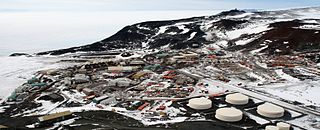
McMurdo Station is a United States Antarctic research station on the south tip of Ross Island, which is in the New Zealand-claimed Ross Dependency on the shore of McMurdo Sound in Antarctica. It is operated by the United States through the United States Antarctic Program (USAP), a branch of the National Science Foundation. The station is the largest community in Antarctica, capable of supporting up to 1,258 residents, and serves as one of three year-round United States Antarctic science facilities. All personnel and cargo going to or coming from Amundsen–Scott South Pole Station first pass through McMurdo. By road, McMurdo is 3 kilometres (1.9 mi) from New Zealand's smaller Scott Base.

The Amundsen–Scott South Pole Station is the United States scientific research station at the South Pole of the Earth. It is the southernmost point under the jurisdiction of the United States. The station is located on the high plateau of Antarctica at 2,835 metres (9,301 ft) above sea level. It is administered by the Office of Polar Programs of the National Science Foundation, specifically the United States Antarctic Program (USAP). It is named in honor of Norwegian Roald Amundsen and Briton Robert F. Scott, who led separate teams that raced to become the first to the pole in the early 1900s.

The Lockheed LC-130 is a ski-equipped United States Air Force variant of the C-130 Hercules used in the Arctic and Antarctic. Ten are currently in service with the 109th Airlift Wing of the New York Air National Guard.
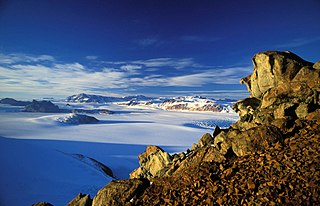
The Transantarctic Mountains comprise a mountain range of uplifted rock in Antarctica which extend, with some interruptions, across the continent from Cape Adare in northern Victoria Land to Coats Land. These mountains divide East Antarctica and West Antarctica. They include a number of separately named mountain groups, which are often again subdivided into smaller ranges.

McMurdo Sound is a sound in Antarctica. It is the southernmost navigable body of water in the world, and is about 1,300 kilometres (810 mi) from the South Pole.
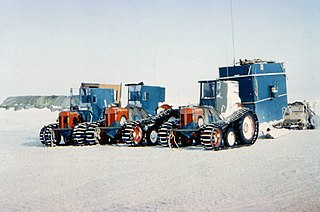
The Commonwealth Trans-Antarctic Expedition (CTAE) of 1955–1958 was a Commonwealth-sponsored expedition that successfully completed the first overland crossing of Antarctica, via the South Pole. It was the first expedition to reach the South Pole overland for 46 years, preceded only by Amundsen's expedition and Scott's expedition in 1911 and 1912.

The United States Antarctic Program is an organization of the United States government which has presence in the Antarctica continent. Founded in 1959, the USAP manages all U.S. scientific research and related logistics in Antarctica as well as aboard ships in the Southern Ocean.

Kenn Borek Air is an airline based in Calgary, Alberta, Canada. It operates regional passenger and cargo services, contract operations in the Arctic and Antarctic and aircraft leasing. Its main base is at Calgary International Airport. It charters aircraft for scientific expeditions, oil exploration, etc., and operates air ambulance services.

Marambio Station is a permanent, all year-round Argentine Antarctica station named after Vice-Commodore Gustavo Argentino Marambio, an Antarctic aviation pioneer. It is located in Marambio Island, Graham Land, Antarctic Peninsula, some 100 km (60 mi) from the coastal civilian village of Esperanza.
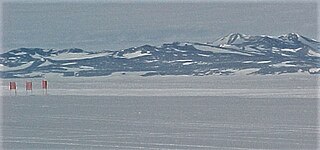
A blue ice runway is a runway constructed in Antarctic areas with no net annual snow accumulation. The density of the ice increases as air bubbles are forced out, strengthening the resultant ice surface so that aircraft landings using wheels instead of skis can be supported. Such runways simplify the transfer of materials to research stations, since wheeled aircraft can carry much heavier loads than ski-equipped aircraft.
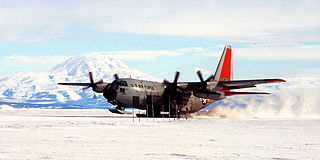
Williams Field or Willy Field is a United States Antarctic Program airfield in Antarctica. Williams Field consists of two snow runways located on approximately 8 meters (25 ft) of compacted snow, lying on top of 8–10 ft of ice, floating over 550 meters (1,800 ft) of water. The airport, which is approximately seven miles from Ross Island, serves McMurdo Station and New Zealand's Scott Base. Until the 2009–10 summer season, Williams was the major airfield for on-continent aircraft operations in Antarctica.

The NimrodExpedition of 1907–1909, otherwise known as the British Antarctic Expedition, was the first of three successful expeditions to the Antarctic led by Ernest Shackleton and his second expedition to the Antarctic. Its main target, among a range of geographical and scientific objectives, was to be first to the South Pole. This was not attained, but the expedition's southern march reached a Farthest South latitude of 88° 23' S, just 97.5 nautical miles from the pole. This was by far the longest southern polar journey to that date and a record convergence on either Pole. A separate group led by Welsh Australian geology professor Edgeworth David reached the estimated location of the South Magnetic Pole, and the expedition also achieved the first ascent of Mount Erebus, Antarctica's second highest volcano.

The South Pole Traverse, also called the South Pole Overland Traverse, is an approximately 995-mile-long (1,601 km) flagged route over compacted snow and ice in Antarctica that links McMurdo Station on the coast to the Amundsen–Scott South Pole Station, both operated by the National Science Foundation of the United States. It was constructed by levelling snow and filling in crevasses; flags mark its route from McMurdo Station across the Ross Ice Shelf to the Leverett Glacier, where the route ascends to the polar plateau and on to the South Pole.
The Antarctica Marathon® may have been the first for-profit sporting event held in Antarctica, on January 28, 1995. The event is now held every year in late February or early March. The 42.195-kilometre race is held on King George Island, one of the largest Antarctic Islands just off the Antarctic Peninsula. There is also a half-marathon held at the same time. The start and finish is at Bellingshausen Station, and the course passes the Artigas Base (Uruguayan), the Frei Base (Chilean) and the Great Wall Base (Chinese). The course follows a gravel road that connects the bases and changes each year based on the base operations as well as road and weather conditions.

Marble Point is a rocky promontory on the coast of Victoria Land, Antarctica, located at 77° 26' S latitude and 163° 50' E longitude. The United States operates a station at the point. The outpost is used as a helicopter refueling station supporting scientific research in the nearby continental interior such as the McMurdo Dry Valleys. Dependent upon the weather conditions at the time, helicopters are able to fly in and out of the station 24 hours a day during the summer research season.

Patriot Hills Base Camp was a private seasonally occupied camp in Antarctica. It was located in the Heritage Range of the Ellsworth Mountains, next to the Patriot Hills that gave it its name.

The South Pole, also known as the Geographic South Pole, Terrestrial South Pole or 90th Parallel South, is one of the two points where Earth's axis of rotation intersects its surface. It is the southernmost point on Earth and lies antipodally on the opposite side of Earth from the North Pole, at a distance of 12,430 miles in all directions.

Arctic Trucks is an Icelandic company with operations in the United Kingdom, Norway, Finland, Poland, Russia and the United Arab Emirates. They specialise in the re-engineering and after market tuning of four wheel drive vehicles to allow them to be used in challenging conditions.

Antarctic Development Squadron Six was a United States Navy air test and evaluation squadron based at Naval Air Station Point Mugu, California with forward operating bases at Christchurch, New Zealand and McMurdo Station, Antarctica.

The South Pole–Queen Maud Land Traverse (SPQMLT) was a three-part scientific exploration of Antarctica undertaken by the United States in the 1960s. The three parts, referred to individually as South Pole–Queen Maud Land Traverse I, II, and III, traveled a zigzag route across nearly 4200 km of the Antarctic Plateau in the austral summers of 1964–1965, 1965–1966, and 1967–1968. The participants included scientists from Belgium, Norway, and the United States. Their objectives included determining the thickness of the Antarctic Ice Sheet, the elevation and slope of its surface, the rate of ice accumulation, and the subglacial topography. Other objectives included measuring the density and temperature of the ice at depth, measuring the geomagnetic field and gravity, and obtaining snow samples and ice cores.




















